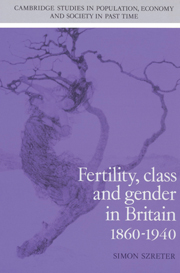Book contents
- Frontmatter
- Contents
- List of figures
- List of tables
- Acknowledgements
- List of abbreviations
- Introduction
- Part I Historiographical introduction: a genealogy of approaches
- Part II The professional model of social classes: an intellectual history
- Part III A new analysis of the 1911 census occupational fertility data
- 6 A test of the coherence of the professional model of class-differential fertility decline
- 7 Multiple fertility declines in Britain: occupational variation in completed fertility and nuptiality
- 8 How was fertility controlled? The spacing versus stopping debate and the culture of abstinence
- Part IV Conceptions and refutations
- Appendices
- Bibliography
- Index
- Cambridge Studies in Population, Economy and Society in the Past Time
6 - A test of the coherence of the professional model of class-differential fertility decline
Published online by Cambridge University Press: 16 February 2010
- Frontmatter
- Contents
- List of figures
- List of tables
- Acknowledgements
- List of abbreviations
- Introduction
- Part I Historiographical introduction: a genealogy of approaches
- Part II The professional model of social classes: an intellectual history
- Part III A new analysis of the 1911 census occupational fertility data
- 6 A test of the coherence of the professional model of class-differential fertility decline
- 7 Multiple fertility declines in Britain: occupational variation in completed fertility and nuptiality
- 8 How was fertility controlled? The spacing versus stopping debate and the culture of abstinence
- Part IV Conceptions and refutations
- Appendices
- Bibliography
- Index
- Cambridge Studies in Population, Economy and Society in the Past Time
Summary
Introduction
In the historiographical review at the outset it was observed that it seems always to have been accepted – either explicitly or simply by default – that falling fertility in Britain was a unitary phenomenon primarily characterised by a pattern of graded social class-differentials. This model has acted as a premise for all attempts to explain the causation involved. In the intervening chapters of Part II the ideological roots and the intellectual provenance of this particular model, ‘the professional model’, have been unearthed. It has been shown how this representation of social structure became so firmly grafted into the tradition of study of Britain's falling fertility. The unitary, hierarchical professional model was adopted as the official classification scheme specifically in order to interpret the data derived from the comprehensive inquiry into the nation's fertility taken as part of the 1911 census. In this way the professional model became intimately associated from the start with the rigorous study of declining fertility in Britain, occupying pride of place in the seminal document which provides the most authoritative historical source of demographic evidence: the Fertility of Marriage Report of the 1911 census.
As long as the empirical evidence continues to be looked at through the unitary hierarchical lens of the professional model students of the problem will continue to give greatest respect and consideration only to those kinds of general explanations and hypotheses which might be able to explain an apparently unified general process, socially graded in its incidence.
- Type
- Chapter
- Information
- Fertility, Class and Gender in Britain, 1860–1940 , pp. 285 - 309Publisher: Cambridge University PressPrint publication year: 1996



